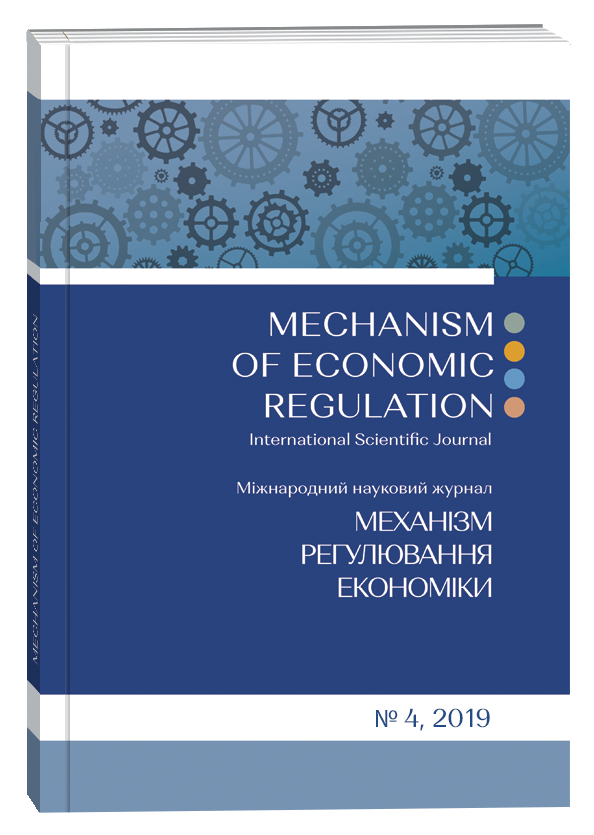ASSESSMENT OF COUNTRY INVESTMENT ATTRACTIVENESS EVALUATION APPROACHES
Abstract
Investment attractiveness of a country, and approaches to its evaluation have been thoroughly debated over few last decades. Initially, the key question concerned the reasons as to why large number of resource holders (financial funds, technologies, management systems etc.) would locate their assets, especially research and development projects, in other countries rather than remaining in their home economies. Increasing the quantity and quality of contacts with developed countries within investment process is crucially important for the development of Ukrainian economy. As follows from that point, the authors have identified features of approaches to investment attractiveness evaluation on a macroeconomic level analyzing latest works of scientists and researchers around the world. It is believed, that the most valuable type of investments for future GDP growth is funds from multinational corporations: they bring not only money, but technologies, and decision how make new businesses profitable. Thus, the fundamental consideration for countries competing for investments is the influencing and improvement of such factors through effective investment incentives policies. Within this work, we researched recent studies of investment attractiveness evaluation around the world, and assumed key points for improving and applying those approaches in Ukrainian economy. Within literature analysis the authors structured approaches to the evaluation based on the methods and subjects those approaches used. The most common methods are related to econometric analysis of statistical data that is collected and published by international institutions and rating agencies. Current analysis shows a tangible dependence between country investment attractiveness and the dynamics of FDI inflows. This dependence is not always straightforward, which is explained by influence of many other determinants within decision-making process. The authors suggest that involving independent experts from respective sectors of the economy could help to optimize the results of statistical data analysis. The expert survey provides the necessary correction coefficients which are to increase the accuracy and relevance of the investment attractiveness evaluation. The authors proposed a generalized approach to assessing the country investment attractiveness, taking into account international experience and features of the Ukrainian economy.
References
Thompson, A. & Strickland A. (1999). Strategic management – Concept and Cases 11th ed. McGraw-Hill Companies, 1088 p.
Makino, S., Lau, C.-M., & Yeh, R.-S. (2002). Asset-Exploitation Versus Asset-Seeking: Implications for Location Choice of Foreign Direct Investment from Newly Industrialized Economies. Journal of International Business Studies, 33(3), 403–421.
Kulczycka, J., Nowaczek, A., Hałasik, K., Whirt, H., Szkop, R (2017). The analysis of factors, barriers and conditions that affect the attractiveness of mining investment in Poland - own research. Mining Science; 24, 209–226.
Snieska, V., & Zykiene, I. (2015). City Attractiveness for Investment: Characteristics and Underlying Factors. Procedia − Social and Behavioral Sciences, 213, 48–54.
Combs, J. G., Ketchen, D. J., Crook, T. R., & Roth, P. L. (2011). Assessing cumulative evidence within ‘Macro' research: Why meta-analysis should be preferred over vote counting. Journal of Management Studies, 48(1), 178–197.
Geyskens, I., Krishnan, R., Steenkamp, J. B., & Cunha, P. V. (2009). A review and evaluation of meta-analysis practices in management research. Journal of Management, 35(2), 393–419.
Bailey, N. (2018). Exploring the relationship between institutional factors and FDI attractiveness: A meta-analytic review. International Business Review, 27(1), 139–148.
Kaufmann, D., Kraay, A., & Mastruzzi, M. (2011). The Worldwide Governance Indicators: Methodology and Analytical Issues. Hague Journal on the Rule of Law, 3(02), 220–246.
Globerman, S., & Shapiro, D. (2003). Global foreign direct investment flows: the role of governance infrastructure. World Development, 30, 1899–1919.
Mathur, A., & Singh, K. (2013). Foreign direct investment, corruption and democracy. Applied Economics, 45(8), 991–1002.
Asiedu, E. (2003). Foreign Direct investment to Africa the role of Government Policy, governance and Political Instability. Department of Economics. University of Kansas.
Busse, M., & Hefeker, C. (2007). Political risk, institutions and foreign direct investment. European Journal of Political Economy, 23, 397–415
Fukumi, A., & Nishijima, S. (2010). Institutional quality and foreign direct investment in Latin America and the Caribbean. Applied Economics, 42(14), 1857–1864.
Böckem, S., & Tuschke, A. (2010). A Tale of Two Theories: Foreign Direct Investment Decisions from the Perspectives of Economic and Institutional Theory. Schmalenbach Business Review, 62(3), 260–290.
Buckley, P. J., Clegg, J., & Wang, C. (2007). Is the relationship between inward FDI and spillover effects linear? An empirical examination of the case of China. Journal of International Business Studies, 38(3), 447–459.
Kotlarsky, J., & Oshri, I. (2008). Country attractiveness for offshoring and offshore outsourcing: additional considerations. Journal of Information Technology, 23(4), 228–231.
Gleißner, W., Helm, R., & Kreiter, S. (2013). Measurement of competitive advantages and market attractiveness for strategic controlling. Journal of Management Control, 24(1), 53–75.
Dawid, H., & Reimann, M. (2005). Evaluating Market Attractiveness: Individual Incentives Versus Industry Profitability. Computational Economics, 24(4), 321–355.
Dierkes, M., Erner, C., & Zeisberger, S. (2010). Investment horizon and the attractiveness of investment strategies: A behavioral approach. Journal of Banking & Finance, 34(5), 1032–1046.
Bouchoucha, N., & Benammou, S. (2018). Does Institutional Quality Matter Foreign Direct Investment? Evidence from African Countries. Journal of the Knowledge Economy.
World Bank (2018). World Development Indicators 2018. World Bank. Retrieved from https://data.worldbank.org/indicator.


